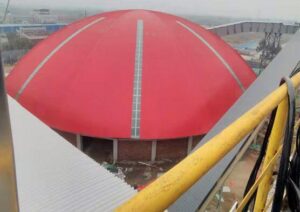Introduction
Limestone storage sheds stand as strong keeper across various industries, silently playing a crucial role in storage and preservation. These sheds are more than just the structures; they are a proof to endure the qualities of limestone and its widespread applications.
Construction and Design
- Construction Materials: Limestone storage sheds are primarily constructed using limestone blocks, a robust and resilient natural material. These blocks provide a solid foundation, ensuring the long span of the structure even in challenging environments.
- Design Considerations: The design of limestone storage sheds involves accurate planning to meet industry-specific needs. Factors like size, ventilation, and accessibility are carefully considered. The size ensures optimal storage capacity, ventilation prevents moisture build-up, and accessibility facilitates easy loading and unloading processes.
Benefits of Limestone Storage Sheds
- Durability: One of the primary advantages of using limestone storage sheds is their exceptional durability. Limestone, known for its strength, ensures that these sheds can withstand the test of time and environmental pressures.
- Resistance to Weathering: Limestone’s natural resistance to weathering is a standout feature. These sheds remain steadfast against the elements, be it burning sun, heavy rains, or freezing cold, ensuring the stored materials stay protected.
- Low Maintenance: Limestone storage sheds boast low maintenance requirements. The material’s natural durability reduces the need for frequent repairs or replacements, making them a cost-effective choice in the long run.
Applications
Limestone storage sheds find applications in the several industries, each benefiting from the unique qualities of limestone.
- Agriculture: In agriculture, these sheds provide secure storage for crops, fertilizers, and equipment, safeguarding them from the effects of changing weather.
- Mining: In the mining industry, limestone sheds serve as repositories for minerals and ores, shielding them from degradation due to exposure.
- Construction: The construction sector utilizes these sheds for storing raw materials and finished products, ensuring a constant supply chain.
Environmental Impact
Limestone’s contribution to sustainability extends beyond its durability.
- Reduced Carbon Footprint: The extraction and processing of limestone often involve lower energy consumption compared to alternative building materials, contributing to a reduced carbon footprint.
- Recyclability: Limestone is a recyclable material, and the construction of storage sheds using limestone allows for the possibility of repurposing or recycling the material in the future, minimizing waste.
Conclusion
Limestone storage sheds represent a perfect blend of strength and sustainability. From construction to diverse applications, these sheds prove their worth in various industries. By choosing limestone, we not only invest in durability and reliability but also contribute to a more environmentally conscious and sustainable future.



